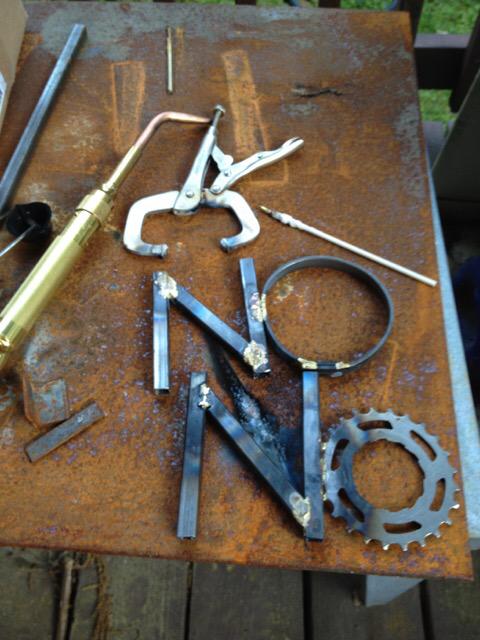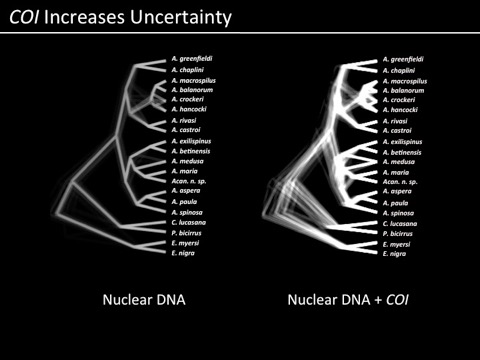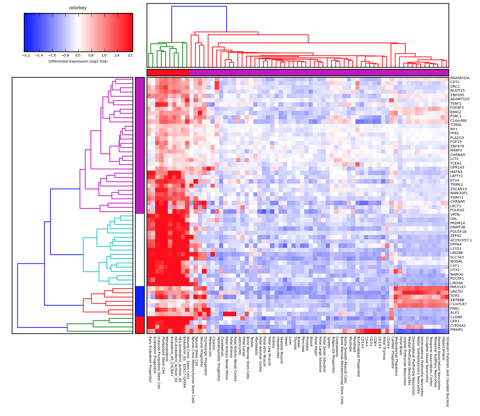publishing
Field and Stream of Consciousness
24/05/17 10:51
Good morning y'all. What a busy time summer is! Tomorrow I will head out to Skidaway Institute of Oceanography, one of the USG marine labs, to collect some Chthamalus for a project one of my undergraduates (Katie Skoczen) has started. I can't quit you, barnacles! And of course a nice little chance to drop by the beach before Memorial Day weekend too. After that, a short writing retreat and research prep trip to Friday Harbor Laboratories, my touchstone for my entire basis as a marine zoologist. Really looking forward to that!
I mention all this fun and hurry because we ARE all so busy. At some point it just feels good, maybe necessary, to call something "done". So I'm happy to also point to a new PeerJ PrePrint from the lab, work that my other fantastic undergraduate Katelyn Chandler has contributed to.
https://peerj.com/preprints/2990/

Shown is Figure 3 from this manuscript. We think we are homing in on a story to tell about Pisaster and tolerance to Sea Star Wasting Disease! What this figure shows is changes in expression: individuals carrying the ins mutation on the left in each panel, individuals without on the right. All 3 panels tell the same story: the ins heterozygotes have dramatically lower expression of HUNDREDS of loci than homozygotes do. The first panel is all data; the second panel excludes one individual because it appears to be a funny recombinant (Katelyn's project for this Fall semester); and the third panel is focused on the elongation factor 1-alpha gene. You'll have to read the paper to know why all of this is so interesting!
As with some of my other papers, I have doubts about putting this paper at a "non-impact" journal like PeerJ, one that is focused through peer review on the correct analysis and interpretation rather than whether the story is sexy. Of course I think this story is sexy! But it has already been rejected without review from 2 journals, which reminds me (A) big data is not a big deal in an era of big data, and (B) all of the ego stroking of science often flows through a small handful of gatekeepers and reviewers. They may not be wrong, but lets remember they don't represent the ultimate impact of the science.
That, and the fact that I have very little funding to splurge on many of the more expensive OA journals (did you know Nature Communications costs $5200? Does that seem like those funds could be better used for science in an era of thin funding??? and yet that isn't Nature, it is another journal generated for the hunger of so many scientists needing to publish their work), and that I feel I can get this story out even if name recognition of the cover of the journal isn't as big for some of my colleagues, is why I continue to go with the good publishing experience at PeerJ.
I mention all this fun and hurry because we ARE all so busy. At some point it just feels good, maybe necessary, to call something "done". So I'm happy to also point to a new PeerJ PrePrint from the lab, work that my other fantastic undergraduate Katelyn Chandler has contributed to.
https://peerj.com/preprints/2990/

Shown is Figure 3 from this manuscript. We think we are homing in on a story to tell about Pisaster and tolerance to Sea Star Wasting Disease! What this figure shows is changes in expression: individuals carrying the ins mutation on the left in each panel, individuals without on the right. All 3 panels tell the same story: the ins heterozygotes have dramatically lower expression of HUNDREDS of loci than homozygotes do. The first panel is all data; the second panel excludes one individual because it appears to be a funny recombinant (Katelyn's project for this Fall semester); and the third panel is focused on the elongation factor 1-alpha gene. You'll have to read the paper to know why all of this is so interesting!
As with some of my other papers, I have doubts about putting this paper at a "non-impact" journal like PeerJ, one that is focused through peer review on the correct analysis and interpretation rather than whether the story is sexy. Of course I think this story is sexy! But it has already been rejected without review from 2 journals, which reminds me (A) big data is not a big deal in an era of big data, and (B) all of the ego stroking of science often flows through a small handful of gatekeepers and reviewers. They may not be wrong, but lets remember they don't represent the ultimate impact of the science.
That, and the fact that I have very little funding to splurge on many of the more expensive OA journals (did you know Nature Communications costs $5200? Does that seem like those funds could be better used for science in an era of thin funding??? and yet that isn't Nature, it is another journal generated for the hunger of so many scientists needing to publish their work), and that I feel I can get this story out even if name recognition of the cover of the journal isn't as big for some of my colleagues, is why I continue to go with the good publishing experience at PeerJ.
Backlog Manifesto
05/07/15 13:25

small brazing project, JPW, 2011.
Summer is a time to gain perspective, at least in the academic world where we are fortunate to have a break from teaching and committee work (or at least, less of it). For many of us, this is a time for field work and travel to conferences, a time to catch up on the writing and analysis that was put off by the pressures of teaching. It's also when we make good on a lot of promises to kids, to family, to ourselves.
I just took my first real vacation in a long time. It was unrelated to work, unrelated to research. I did as little email-checking as I needed to, though there were a few tasks to keep juggling. And it is probably really trite to come back from vacation with a clarity that "life should be more like this", but there you have it.
I have been faculty for 10 years. I've literally lost count of how many PhDs, masters, and undergrad students I have shepherded through the process of research, how many different classes I have taught, even how many of my colleagues I was on committee to hire. I'm one of the semi-old guys now. I've had plenty of funding for my research, published a lot of it. I've been graduate coordinator for 4 years, and let me tell you that is both thankless and rewarding at the same time.
What concerns me about the academic life is the pressure to keep it up, to go more and more and more. Some of this is self-inflicted, of course, but we all know the numbers games that our university administrators are running, as well. For me, this has led to a lifestyle of juggling so many different projects that I recognize fully how each is being short-changed, and the people on them as well.
When I commit to a graduate committee, or to a student being in my lab, I should be committing sufficient time to that person that they will truly gain from the interaction – not that they will have to squeeze in a few half-baked moments with me when I spend half the time recuperating my understanding of what they are doing because it has been a few weeks since we discussed it and I've had to change mental focus so many times and haven't slept well and, and, and. Period. And I worry that isn't happening.
I'm not able to read much these days; I glean. I use close to a month of work hours to being grad coordinator, probably another month to basic administration of the lab (ordering, repairing, etc.) itself, and that is not at all dismissing the work my grads put in to the same tasks. I throw myself into teaching, and have been shuffled to new teaching assignments often enough that nothing is in balance (at least it isn’t getting stale!). And most importantly, I'm having a hard time finishing what I started because I feel the pressure to start something new. This is what I'm about to tell you, needs to stop.
So, though I am on about 3 pending proposals, and associated intellectually with a couple more, I am not submitting any more this year. Or maybe next. Funding is a precious commodity for research. My effort now is not scratching my head for ideas that might be fundable, to keep the treadmill at full speed, but to focus on the ongoing work and let it identify for me what ideas need to be funded, and how. What ideas arise organically, are useful, are critical to pursue? What are the priorities? Our planet, biodiversity, public health, as well as knowledge; each of us would come up with a different list of course.
I am helping 2 students finish their PhDs, and another 6 (unless I’ve forgotten somebody, which wouldn’t be surprising) that I'm currently on their graduate committees (in the past I have been on many more at once). That feels like enough, knowing all it takes in the last push. Including those who have recently finished - a masters student, postdocs, colleagues from other labs - I have at least 20, probably many more, manuscripts that are all in various stages of being written or generated. That is enough to keep me busy for years in and of itself! I want to do this science right, to do it the best possible way, rather than frantically pushing it away to get to the next thing. The people involved deserve my attention.
Notice how committee and commitment are related...?
This also means that travel is something that I am limiting. Travel is one of the true perks of a biologist, and I have excellent and dear colleagues all over the planet at this point. I get invited for talks, I get invited for intense one-on-ones about research or collaboration, and of course there are intriguing conferences where you get the opportunity to see more of the same people but in new! exciting! places where you still drink at the bar across the street from the conference center.... and I have to say no most of the time. If I have told you “no” recently, you aren’t alone. The environmental costs of flying are high, and this is a true priority to consider. The time (and financial) costs of travel are high as well, and I have to prioritize which ones are possible in the scope of all else I do professionally and personally. I think I would be interested to see how extended teleconferencing (Google hangouts, Skype, FaceTime, etc.) could replace some of these interactions – sure, you miss the local cuisine and some beers, and some research interactions are minimized – but we shouldn't neglect this magic that has transformed our professional lives in recent years, either.
This is a long justification for why you will hear "No" from me more often than in the past. I’m not doing anything other than recognizing my career as a long-distance run rather than a sprint, I’m trying to do right by those whom I am already committed to helping, I'm trying to do justice to the science I've already committed to, and I'm trying to do what is best for my family and personal needs as well. And I promise – and some of you know I’ve been up front about this in recent requests to come give a seminar, etc. – I won’t be offended if you tell me “No” as well.
Live CV
11/07/14 16:28
| Just a note that I’ve decided the CV is dead. A bunch of pieces of paper stapled together, a big list of mostly irrelevant information to your needs. If you want to decide what my impact as a scientist is, it has nothing to do with the names of journals I have published in. It really doesn’t matter what university I’m at - or if I’m at a university at all. If I’m able to sell my ideas, I get grants. That funding helps me travel, collect data, support students. Those efforts let me answer questions. If my answers are useful, people will refer to those publications and data sets and continue the march of science. As such, you don’t need a few pieces of paper stapled together to sift through. I have started my | Live CV page, which you click on and can see the progress of my publications. I will work on adding a location that summarizes my funding sources.
Seahawks
11/03/14 11:15
My son loves the Seattle Seahawks, and so in my house we notice when something about the Seahawks is in the news. My wife Jenny - a health care professional herself - just came across this story the other day on ESPN about the relaxed atmosphere instilled in their practice camp, including meditation and yoga as part of their weekly or even daily routine.

Almost on the same day, I had come across a series of TED talks about productivity in the workplace and how to best foster it. This is both for my own growth as a professional, trying not to get too caught up in the administrative tangle of a university while maintaining my trajectory as a biologist, as well as figuring out how best to work with students and colleagues.
One of the talks in particular was about leadership and productivity, and how engendering pleasant work environments - positive attitude, happy workers - leads to higher productivity, rather than the other way around. It triggered a lot of thoughts about how we use these ideas in graduate training, something that to me is a combination of medieval apprenticeship and modern-day productivity. We are training people how to do what we do, but we are also trying to get things done with them and through them. So how do we make this training experience best for students and mentors alike?
I try but I’m sure it could improve. I think I have happy students - at least, as happy as a grad student can be with all of the stresses of finishing a thesis and juggling the real life outside of these walls! But I know that as a department, we haven’t given much thought to how to work on the morale of the troops, how to calmly handle the fears and insecurities of generating ideas and backing those ideas up with data. This might be a good thing to think about before our next departmental retreat.

Almost on the same day, I had come across a series of TED talks about productivity in the workplace and how to best foster it. This is both for my own growth as a professional, trying not to get too caught up in the administrative tangle of a university while maintaining my trajectory as a biologist, as well as figuring out how best to work with students and colleagues.
One of the talks in particular was about leadership and productivity, and how engendering pleasant work environments - positive attitude, happy workers - leads to higher productivity, rather than the other way around. It triggered a lot of thoughts about how we use these ideas in graduate training, something that to me is a combination of medieval apprenticeship and modern-day productivity. We are training people how to do what we do, but we are also trying to get things done with them and through them. So how do we make this training experience best for students and mentors alike?
I try but I’m sure it could improve. I think I have happy students - at least, as happy as a grad student can be with all of the stresses of finishing a thesis and juggling the real life outside of these walls! But I know that as a department, we haven’t given much thought to how to work on the morale of the troops, how to calmly handle the fears and insecurities of generating ideas and backing those ideas up with data. This might be a good thing to think about before our next departmental retreat.
Representation
19/02/14 12:04
When I first started doing science, visualization of our data and results was a bit easier. Sequence a gene from 20-30 individuals, generate a phylogenetic hypothesis, make it look pretty, Figure 1. As we have moved to information from more and more loci (or greater numbers of samples, or any other factor of additional complexity), there have been ways developed to summarize the results visually for the purposes of proving to the audience of a journal article that you are on the right track in terms of interpretation. For example, former postdoc (and now faculty at Texas A&M - Galveston) Ron Eytan used these images to show which parts of a phylogeny were consistently supported and which were not (an image that overlays many reconstructions of a phylogeny from the same data):

and we are now becoming familiar with things like transcriptome heat maps to illustrate over/under expression of particular genes:

and to an extent, we have just become accustomed to more complicated representations of data and results residing only as online supplemental files. In other words, often the most important components of science are no longer able to be represented in the standard peer-reviewed journal article. We are at this point often having to take into consideration representation of science through multiple filters: how will it communicate to the audience? what if that audience is looking only at a photocopy, or black-and-white print of my article? what if that audience is unable to afford the journal I submit to?
but what I’m grappling with today, is what if there is no single view, even if it is a figure with multiple panels, that can explain your results the same way that having an animation, in particular an interactive animation, could do?
the above is a representation of fitting in silico particles (representing barnacle larvae) to a coastal oceanographic system with environmental selection on the two lineages of barnacle that we are studying. The bottom plot shows frequencies of the northern and southern types plotted against latitude, and as the movie plays it shows how the oceanography and selection interact to fit simulated data to empirical data. This alone is a daunting amount of information. But we can vary so many parameters: depth of larval release, time in the water column, strength of selection, cost functions, the fit to over 100 distinct loci for which we have data, inter annual variation. There is almost no way to represent the complexity of this story - adequately! - in the illustrations we typically put together for a science publication. So it will probably end up that many of these movies will be online supplements. But I wonder: when will our expectations of “publishing” science catch up with the technology with which we DO science?

and we are now becoming familiar with things like transcriptome heat maps to illustrate over/under expression of particular genes:

and to an extent, we have just become accustomed to more complicated representations of data and results residing only as online supplemental files. In other words, often the most important components of science are no longer able to be represented in the standard peer-reviewed journal article. We are at this point often having to take into consideration representation of science through multiple filters: how will it communicate to the audience? what if that audience is looking only at a photocopy, or black-and-white print of my article? what if that audience is unable to afford the journal I submit to?
but what I’m grappling with today, is what if there is no single view, even if it is a figure with multiple panels, that can explain your results the same way that having an animation, in particular an interactive animation, could do?
the above is a representation of fitting in silico particles (representing barnacle larvae) to a coastal oceanographic system with environmental selection on the two lineages of barnacle that we are studying. The bottom plot shows frequencies of the northern and southern types plotted against latitude, and as the movie plays it shows how the oceanography and selection interact to fit simulated data to empirical data. This alone is a daunting amount of information. But we can vary so many parameters: depth of larval release, time in the water column, strength of selection, cost functions, the fit to over 100 distinct loci for which we have data, inter annual variation. There is almost no way to represent the complexity of this story - adequately! - in the illustrations we typically put together for a science publication. So it will probably end up that many of these movies will be online supplements. But I wonder: when will our expectations of “publishing” science catch up with the technology with which we DO science?